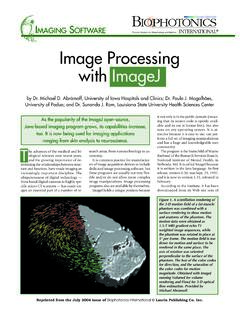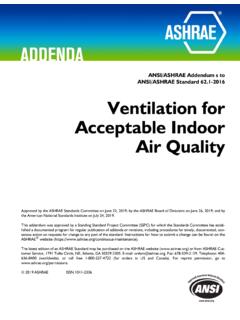Transcription of Guidelines for the Safe Handling and Disposal of Chemicals ...
1 Guidelines for theSafe Handling and Disposal of Chemicals used in the illicit manufacture of drugsVienna International Centre, PO Box 500, 1400 Vienna, Austria Tel.: (+43-1) 26060-0, Fax: (+43-1) 26060-5866, Nations publicationPrinted in AustriaSales No. *1183777* September 2011 300 USD 26 ISBN 978-92-1-148266-9 Guidelines for theSafe Handling and Disposal of Chemicals used in the illlicit manufacture of drugsUNITED NATIONSNew York, 2011ST/NAR/36 NATIONS PUBLICATIONS ales No. 978-92-1-148266-9eISBN 978-92-1-055160-1 Symbols of United Nations documents are composed of letters combined with figures. Mention of such symbols indicates a reference to a United Nations document. United Nations, September 2011. All rights designations employed and the presentation of material in this publication do not imply the expression of any opinion whatsoever on the part of the Secretariat of the United Nations concerning the legal status of any country, territory, city or area, or of its authorities, or concerning the delimitation of its frontiers or for permission to reproduce this work are welcomed and should be sent to the Secretary of the Publications Board, United Nations Headquarters, New York, 10017, or also see the website of the Board: Governments and their institutions may reproduce this work without prior authoriza-tion but are requested to mention the source and inform the United Nations of such publication has not been formally production.
2 English, Publishing and Library Section, United Nations Office at and acknowledgementsThe first United Nations Office on Drugs and Crime (UNODC) Guidelines for the Safe Disposal of Chemicals used in the illicit manufacture of Drugs (STNAR/36) was published in 2006 and was the culmination of an expert group meeting on Environmentally safe methods for the destruction/ Disposal of Chemicals , organized in collaboration with the Multilateral Environmental Agreements Branch of the United Nations Industrial Development Organization (UNIDO), in Vienna, Austria, from 6 to 8 September 2005. The availability of the Guidelines in Spanish was facilitated by the Inter-American Drug Abuse Control Commission (CICAD), Organization of American States (OAS).At the 33rd meeting of the Heads of Law Enforcement Agencies (HONLEA) Asia and Pacific, in Bali, Indonesia in 2010, Member States noted the significant increase in precursor Chemicals discovered regionally and expressed concern about the dif-ficulties encountered in storing and disposing of precursor Chemicals in a safe and environmentally friendly manner.
3 An Expert Group Meeting on Safe and Environ-mentally-Responsible Disposal of Chemicals Used in the Illicit Manufacture of Drugs was held in Bangkok, Thailand from 20 to 22 September 2010. The experts reviewed the existing UNODC Guidelines with respect to its applicability to the emerging trends in regional drug manufacturing. The present Guidelines reflect the discussions of the experts and the elaboration of practical methods for the safe Handling and Disposal of seized Chemicals in situations where a waste management infrastructure may not be available. The UNODC Laboratory and Scientific Section (UNODC/LSS, headed by Dr. Justice Tettey) wishes to express its gratitude to the following experts who participated in the expert group meeting in Bangkok, Thailand and contributed to the revision of the Guidelines : Mr. Craig Mann, Team Leader, Specialist Response Amphetamine Type Stim-ulants, Australia Federal Police; Dr.
4 Chan Kee Bian, Head of Narcotics Section, Department of Chemistry, Malaysia; Dr. Nathan Green, Forensic Chemist, Australia Federal Police; Dr. Patrick Choi, Principal Technical Advi-sor, NSW Department of Environment, Climate Change and Water, Australia; Dr. Barbara Remberg, Senior Technical Advisor, Precursors Control Section, International Narcotics Control Board, Austria; Dr. Daniel Rothenfluh, Assis-tant Director, Department of the Environment, Water, Heritage and the Arts, Australia; Mr. Wong Hoy Yen, Consultant/Pharmacist, Malaysia; Dr. Hoang Manh Hung, Senior Officer, Institute of Forensic Science, Viet Nam; Mr. Paul Newell, Senior Environmental Officer, Department of Environment and Con-servation (WA), Australia; Mr. H ctor Bernal Contreras, Coordinado Grupo Internacional-Qu mico, Direcci n Nacional de Estupefacientes, Colombia; Mr. Peter Vallely, Special Investigator Forensic Chemist, Australian Crime Commission, Australia; and Ms.
5 Marjorie Ungson Villanueza, Chemist IV, Philippine Drug Enforcement Agency, thanks go to Ms. Pamela Smith (Consultant/Forensic Chemist, Ex United States Drug Enforcement Administration) who authored the background paper used for discussion at the above meeting and finalized the revised version of the Guide-lines and to the UNODC Regional Centre for East Asia and the Pacific (headed by Mr. Gary Lewis) for providing the funds for the revision UNODC/LSS also expresses its gratitude to the following experts who contributed to the development and production of the original Guidelines ; Mr. Mark Colhoun, Dr. Rainer Dahlenburg, Ms. Mary E. Greene, Mr. Ziggie Malyniwsky, Mr. Pabalala Meshack Mthembi, Mr. Teodor Ognean, Ms. Lilia S. Osorio Bryson, Dr. Anil K. Saxena; Mr. wayne K. Jeffery, Mr. Jorge L. Acevedo-Gierbolini and Dr. Howard of the methods for the Handling and Disposal of Chemicals used in the illicit manufacture of drugs described in these Guidelines may result in environmental degradation.
6 Their inclusion in this manual is a matter of practicality, drawing atten-tion to the fact that the Chemicals are often encountered in very difficult circum-stances, where, depending on the specific conditions, the Disposal method presented may be the only alternative, and therefore the best available solution at a given point and time. Inclusion of methods in these Guidelines should not be interpreted as an endorsement by the Laboratory and Scientific Section of the United Nations Office on Drugs and Crime, the United Nations or Inter-American Drug Abuse Control Commission, the General Secretariat of the Organization of American States, or the Organization of American States of their environmental safety, or a recommendation by any of them or by any of their respective personnel that existing environmental protection conventions, treaties, laws or regulations be ignored or of several of the methods included in these Guidelines requires the presence of adequately trained personnel.
7 The Laboratory and Scientific Section of the United Nations Office on Drugs and Crime, the United Nations and the Inter- American Drug Abuse Control Commission, the General Secretariat of the Organiza-tion of American States, the Organization of American States, and their respective personnel are not responsible for any damage to property, or injury to persons, resulting from following these .. 11. CHEMICAL WASTE Disposal AND TREATMENT METHODS .. 5 Chemical waste Disposal methods .. 7 Chemical waste treatment methods .. 102. SPECIFIC DETAILS FOR THE PRACTICAL Disposal OF Chemicals .. 13 Burial pits .. 13 Open burning .. 17 Neutralization .. 20 High temperature incineration using existing industrial plants .. 22 Waste immobilization .. 23 Disposal of containers .. 25 Disposal of controlled substances and their precursors.
8 253. SAFE Disposal OF UNKNOWN/UNLABELLED Chemicals .. 274. PRACTICAL DETAILS FOR CHEMICAL NEUTRALIZATION AND TREATMENT .. 29 Acids .. 30 Bases .. 31 Organic solvents ( ethanol) .. 31 Ethers .. 32 Organic acid halides ( acetyl chloride) .. 32 Aldehydes ( benzaldehyde) and organic halogen compounds ( benzyl chloride) .. 33 Aliphatic amines ( methyl amine) .. 33 Inorganic salts ( aluminium chloride) .. 33 Oxidizing agents ( potassium permanganate, hydrogen peroxide, sodium dichromate) .. 33 Cyanides ( sodium cyanide) .. 35 Hydrides ( lithium aluminium hydride) .. 36 Organic amides ( formamide) .. 36 Non-metallic compounds ( phosphorous trichloride) .. 36 Non-hazardous, solid Chemicals .. 37 Phosphorous (yellow and red) .. 37viPage Alkali metals .. 38 Other metals .. 38 Aqueous solutions of water-miscible flammable organic solvents ( solutions of less than 18 per cent acetone, ethanol, methanol and other water-soluble and water-miscible solvents).
9 38 Iodine .. 39 Gases and compressed/liquefied gases .. 39 Radioactive material ( thorium nitrate) .. 39 Thionyl chloride .. 39 Sodium hypochlorite .. 405. SAFE Handling AND STORAGE OF Chemicals .. 41 Safe Handling of seized Chemicals .. 41 Safe storage of seized Chemicals .. 43 Handling of chemical spills.. 446. POTENTIAL IN-COUNTRY RESOURCES .. 497. THE ROLE OF THE SPECIALIST .. 518. SUMMARY OF LEGAL IMPLICATIONS .. 53 BIBLIOGRAPHY .. 55 GLOSSARY .. 59 Annexes I. Chemicals USED IN THE ILLICIT MANUFACTURE OF DRUGS AND THEIR Disposal METHODS .. 63 II. CHEMICAL TESTS TO BE CONDUCTED ON UNKNOWN OR UNLABELLED SOLIDS AND LIQUIDS .. 71 III. HEALTH, FLAMMABILITY, REACTIVITY AND HAZARD RATINGS .. 77 IV. PHYSICAL PROPERTIES .. 85 V. PROPERTIES OF COMMONLY ENCOUNTERED ACIDS AND BASES .. 91 VI. EQUIPMENT AND MATERIALS REQUIRED FOR Disposal ACTIVITIES.
10 93 VII. MINIMUM HEALTH AND SAFETY PROCEDURES, INCLUDING PERSONAL PROTECTIVE EQUIPMENT .. 95 VIII. GENERAL Guidelines FOR ON-SITE OPERATION .. 97 MODEL SCENARIOS .. 103 1 IntroductionThe safe Handling , storage and Disposal of seized Chemicals , and waste encountered at clandestine drug laboratory sites present unique problems to law enforcement and regulatory authorities. Chemicals used by clandestine laboratory operators in the production of illicit drugs are usually diverted from the legitimate trade and may be encountered at any stage of the licit chain of distribution, or at the clandestine laboratory site. The location where the Chemicals are actually seized, along with their characteristics, quantity and condition, will be determining factors as to how they will be handled. National drug control laws and regulations should provide for the speedy and efficient collection, processing and Disposal of seized Chemicals in a manner that minimizes or eliminates the potential problems resulting from long-term storage and Handling , such as per-sonal and public safety and the possibility of their diversion and subsequent reintro-duction for use in the illicit manufacture of drugs.













